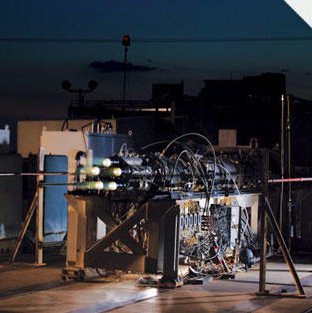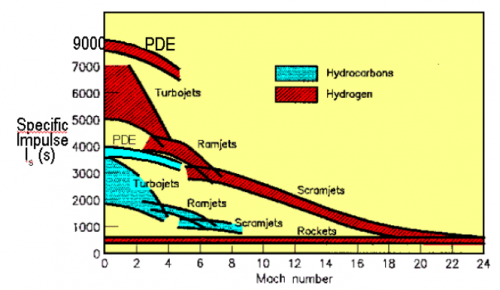Blackkite,
KJ! Fightingirish already post following site for Blackswift topic in June 20 2008.
Please confirm the site.
http://www.darpa.mil/TTO/solicit/BAA08-53/VULCAN_Industry_Day_Presentations.pdf
I checked the site. From what it seems the US Government, and DARPA does intend to ultimately combine the PDE along with other engines so as to ultimately produce a design for space-access. Unfortunately it does bother me that all of this technology will probably only be used for military applications
(putting up satellites -- most of them surveillance oriented, into orbit along with maintaining said satellites, and for potentially direct surveillance in the form of the Blackswift) with any potentially interesting civilian ideas such as hypersonic transports, and affordable space-access for civilians
(While Virgin Galactic is quite impressive, it's is not a single-stage to orbit, it's relatively small, and extremely expensive -- who could afford $200,000 bucks to go into space a few minutes? Actually I can think of quite a couple, such as celebrities, heads of big business, including ultra rich individuals such as Bill Gates, and Warren Buffet and such, but I myself certainly cannot).
One thing that's interesting is the mention of a Continuous Detonation Engine (CDE), which I have wondered about it's practicality as it wouldn't have the jackhammer vibration problems that the PDE would have
(I've been told that it wouldn't be as efficient though however I have no idea what ideas are being cooked up now)
Hi! You mean PDE has big potential for SSTO space plane engine?
That is correct. It would be useful to get a ramjet up to ignition speed, could work along with the ramjet to improve thrust at certain speeds. It is possible to design a ramjet which features variable geometry which can transition from a ramjet to a scramjet. Active cooling can increase the maximum speed at which a ramjet and/or scramjet can operate at. Since the PDE can be cycled into a rocket, it can provide the final push into space.
Quellish,
Yup, looks great on paper, doesn't it?
Well, I have a pretty good feeling it wouldn't work as well under real world conditions as it would on paper, but I think such a design could actually work. The exception is the pulse-frequency rate of the PDE's currently being developed which are around 40-80 cycles per second, I am not certain that could be increased, although there are things I didn't think were possible in the past
(though not all of these things were good). Having a multitude of PDE tubes each firing at slightly different times could produce the effect of a higher frequency-rate. Some of the research in the link depicted did mention a Continuous-Detonation Engine which would get around the jack-hammer vibration issue, but I've been told it wouldn't be as efficient, but for all I know it would still have modern engines beat by miles.
Matej,
Yes, like the warp drive

I think a PDE that could be used to boost a ramjet up to speed, be cycled to behave as a rocket, and developing a ramjet that can alter it's geometry to transition into a ramjet combined with active cooling to increase efficiency and maximum top speed is far more plausible than developing a warp-drive.
I agree that the manufacture it will be a little more difficult task.
Well, it would not be easy to build, but I think it could be done.
A great deal of the technology actually exists already to do the job
- We already have metallic high temperature TPS which in addition to eliminating much of the need for the highly elaborate thermal management systems used on a "hot" design which requires the fuel be used as a heat-sink and elaborate cooling schemes. The only part of the plane that might require a cooling system would be the nose
(If the nose was a sharp-design) which could use a liquid piped coolant. These metallic TPS systems, which have been around since the mid-1960's, according to former McDonnell/McDonnell-Douglas employee
(and, to the best of my knowledge, current Aerospace Engineering Professor) Paul Csysz, are actually lighter, sturdier and more rugged than the thermal tiles used on the Space Shuttle.
- We have the means to achieve hypersonic-flight
(in some cases up to orbital velocity) without the need for blunt-noses. To an extent this capability has existed since the late 1950's
(The AeroSpacePlane program which was from 1957 to 1963 did feature at least some sharp nosed designs, as did some designs out of Wright Patterson's Flight-Dynamics Laboratory or FDL.), and definitely by the 1980's
(While the X-30/NASP design was often depicted as having a blunt-nose, there are some diagrams, pictures of at least one wind-tunnel model, and statements from Paul Csysz that the actual design was to have had a sharp nose). A sharp nose while producing a much higher nose-temp actually produces a great deal less drag, and for a hypersonic waverider design which uses it's forward underbelly as both an inlet and lifting device, it yields a higher pressure recovery and a higher L/D ratio which are all desirable qualities.
- We have scramjet technology, which McDonnell, according to Paul Csysz, had begun research
(IIRC in the late 1950's) and had been tested in wind-tunnels at least by the early 1960's
(if not in the late 1950's) which could generate positive thrust, with some designs able to yield thrust up to Mach 22. Regardless, we certainly do have technology now to produce scramjets with the X-43 being testament to it
(which to the best of my knowledge has achieved Mach 10). A great deal of research has been done to the best of my knowledge which shows that a scramjet duct could be designed to undergo a variable geometry change to "transform" it into a ramjet duct for low speeds. Above a certain speed, the engine would undergo a VG change back into a scramjet duct.
KJ Lesnick



